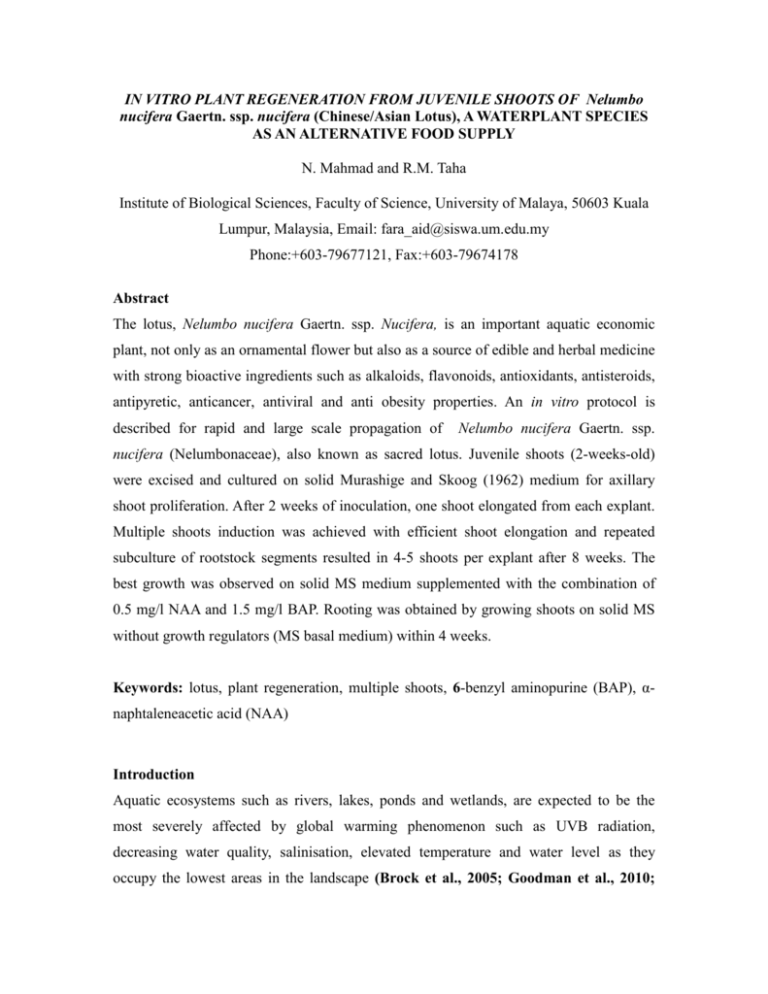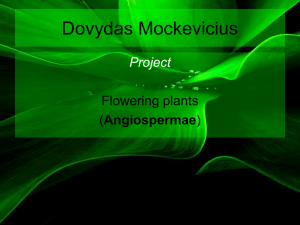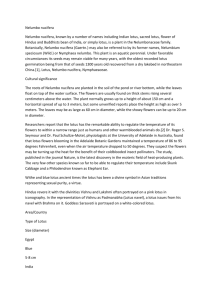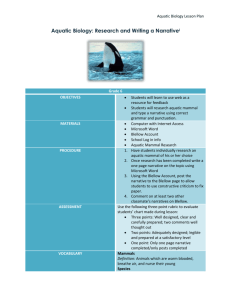Mahmad_full
advertisement

IN VITRO PLANT REGENERATION FROM JUVENILE SHOOTS OF Nelumbo nucifera Gaertn. ssp. nucifera (Chinese/Asian Lotus), A WATERPLANT SPECIES AS AN ALTERNATIVE FOOD SUPPLY N. Mahmad and R.M. Taha Institute of Biological Sciences, Faculty of Science, University of Malaya, 50603 Kuala Lumpur, Malaysia, Email: fara_aid@siswa.um.edu.my Phone:+603-79677121, Fax:+603-79674178 Abstract The lotus, Nelumbo nucifera Gaertn. ssp. Nucifera, is an important aquatic economic plant, not only as an ornamental flower but also as a source of edible and herbal medicine with strong bioactive ingredients such as alkaloids, flavonoids, antioxidants, antisteroids, antipyretic, anticancer, antiviral and anti obesity properties. An in vitro protocol is described for rapid and large scale propagation of Nelumbo nucifera Gaertn. ssp. nucifera (Nelumbonaceae), also known as sacred lotus. Juvenile shoots (2-weeks-old) were excised and cultured on solid Murashige and Skoog (1962) medium for axillary shoot proliferation. After 2 weeks of inoculation, one shoot elongated from each explant. Multiple shoots induction was achieved with efficient shoot elongation and repeated subculture of rootstock segments resulted in 4-5 shoots per explant after 8 weeks. The best growth was observed on solid MS medium supplemented with the combination of 0.5 mg/l NAA and 1.5 mg/l BAP. Rooting was obtained by growing shoots on solid MS without growth regulators (MS basal medium) within 4 weeks. Keywords: lotus, plant regeneration, multiple shoots, 6-benzyl aminopurine (BAP), αnaphtaleneacetic acid (NAA) Introduction Aquatic ecosystems such as rivers, lakes, ponds and wetlands, are expected to be the most severely affected by global warming phenomenon such as UVB radiation, decreasing water quality, salinisation, elevated temperature and water level as they occupy the lowest areas in the landscape (Brock et al., 2005; Goodman et al., 2010; Hart et al., 2003; James et al., 2003; Walker et al., 2002). Despite being recognised as areas of ecological complexity and conservation importance (Davis et al., 2006), aquatic systems continue to be among the world’s most threatened ecosystems (Zedler and Kercher, 2005). The threats will lead the aquatic biota become increasingly stressed, resulting in reduced growth and reproduction (Sim et al., 2006) and ultimately death (Kefford et al., 2007; Nielsen et al., 2003), leading to a decline in species richness (Hart et al., 1990). Lotus one of most important aquatic plants and has the critical role in ecological systems of wetlands, lakes and ponds. The growth of lotus is also affected by water level and its fluctuation. The deepest water level recorded is about 2-3 m for wild lotus (Wang and Zhang, 2005). Recently lotus has been included in the list of endangered species in China (Dong and Zheng, 2005) and America (Sayre, 2004). Nelumbo nucifera The genus Nelumbo, commonly known as lotuses, was previously included in the family Nymphaeaceae. However, based on recent molecular phylogenetic analyses (Barkman et al., 2000; Lee and Wen, 2004), many researchers now place the genus in a separate family, Nelumbonaceae (Kubo et al., 2009). The Nelumbonaceae also known as the lotus family is a small family of perennial, aquatic emergent angiosperms which traditionarily consists of the two species Nelumbo nucifera Gaertn. (Indian or sacred lotus) and Nelumbo lutea (Willd.) Pers. (American lotus or water chinquapin). The former is distributed in Asia and North Australia and the latter is found in North and South America (Borsch and Barthlott, 1996 Han et al., 2007;). Although these two species have distinctive characters, such as petal color and leaf size, they also share many similar characteristics and can easily be hybridized. Hundreds of Nelumbo cultivars exist, mostly in Asia (Zou et al., 1997). The family is characterized by simple, peltate leaves which lack stipules and are borne on the surface of the water. Lotus is a typical hydrophyte that has been cultivated to produce edible tubers in the wetlands of eastern Asian countries. This species has a large, round leaf that expands horizontally at the top of its petiole. The diameter and area of the leaf exceed 0.5 m and 0.25 m2, respectively, in a full growing period (Takagi et al., 2006). There is a common red-flowered form where petals have darker red lines and a very rare form where the petals are dark red at the apices; less common are a white form and an intermediate white-red form. Flowers with less than 25 petals are usually known as singled-flowered, those with 25-50 petals are known as intermediate and those with over 50 petals sre called double-flowered (La-ongsri et al., 2008). The lotus is an important aquatic economic plant, not only as a dainty and ornamental flower but also as a source of herbal medicine with strong bioactive ingredients such as alkaloids, flavonoids, antioxidants, antisteroids, antipyretic, anticancerous, antiviral and anti obesity properties (Mukherjee et al., 1997; Sinha et al., 2000; Qian, 2002; Sridhar and Bhat, 2007). Lotus usually propagated vegetatively through rhizome division or tuber production but normally with low propagation rate growth (Shou et al., 2008). It also can be multiplied through seed but for quick and better germination the seeds need to be scarified by rubbing the outer hard seed coat gently on the sand paper at both ends and finally immersing in water to initiate germination. Scarified seeds will germinate after 3-4 days while normal seeds take 10-15 days to germinate. If the hard coating stays intact, the seed will remain viable for centuries and if placed in water it may take a few years for the seed to sprout (Hartman et al., 1990). Tissue culture of aquatic plants During the past few years, there has been increasing interest in the use of aquatic vascular plants for the removal of pollutants from domestic and industrial sewage effluents (McDonald and Wolverton, 1980). Aquatic macrophytes can take up excessive nutrients and also play a crucial role in creating a favourable environment for a variety of chemical, biological and physical processes that contribute to the nutrient removal and degradation of organic compounds (Gumbricht, 1993; Chong et al, 2004). Of the several plants studied, lotus (N. nucifera) and water hyacinths (Eichhornia crassipes) are among the most commonly cited and appear to have the greatest potential for use in water pollution control and are known to accumulate nutrients (Hailer and Sutton, 1973; Ornes and Sutton, 1975 and Cornwell et al., 1977). Nelumbo is a good bioindicator of trophic changes, assimilation and removal of heavy metals such as chromium removal (Vajpayee et al., 1999) and also can absorb and accumulate Fe, Mn, Cu, Zn, Pb, and Ca (Sun et al., 1987). In order to produce large numbers of these potential aquatic plants for this type of uses, one has to rely on vegetative propagation or sexual reproduction. Unfortunately most aquatic plant species do not produce seeds and plants produced through asexual propagation are time consuming, labor intensive, expensive and not adequate to meet the demands of industry (Thullen and Eberts, 1995). Furthermore the harvesting of aquatic plants from their natural habitat will become a threat to the species richness (Lauzer, 2004). Table 1.0: Wide range of aquatic plant species tissue culture. Species Explants Media Source Nelumbo lutea Excised embryos from Half strength MS + Kane et al., 1988 immature flowers 100mg inositol, 0.4mg thiamine, 100mg/l GA3 Aerial plants Cryptocoryne lucen MS + 0.45mg BAP, Kane et al., 1990 0.1mg NAA Myriophyllum Nodal and internode Liquid half MS + 8mg/l aquaticum segments 2iP Lateral shoots MS + 0.3mg/l BA, 0.01 thiadiazuron and Anubias barteri var. undulata Kane et al., 1991 Huang et al., 1994 0.1 NAA Trapa natans Shoot tips and node Nitsch's basal liquid medium (NBL) + Agrawal and Mohan Ram, 1995 10-6M BAP Scirpus robustus Seedling mesocotyl MS + 1mg/l 2,4-D Wang et al., 2004 Therefore tissue culture is a suitable method to mass propagate aquatic plant species and offers several advantages for industry. Among the advantages is good quality of planting materials which disease and virus free at a competitive price while conserving aquatic plants in their natural habitat. Large scale plant production also can be programmed and preservation of plant species in vitro is also possible (Yapabandara and Ranasinghe, 2006). In vitro propagation is a most efficient and cost effective method of propagating large number of planting materials. The plants produced by in vitro propagation are genetically uniform, vigorous and free from associations with other organisms and useful for the culture of aquatic plants where contaminating organisms can dominate other types of production systems (Alistock and Shafer, 2006). Many tissue cultured water plant species show a more bushy growth with more adventitious shoots, qualities that many will appreciate (Christensen, 1996). Tissue culture has been successfully employed for micro-propagation of a wide range of aquatic plants as stated in Table 1.0 but its application in lotus rarely reported possibly because its recalcitrance to regeneration in vitro (Zhao, 1999). So far, a protocol for flower lotus regeneration (Arunyanart, 1998; Arunyanart and Chaitrayagun, 2005) and in vitro multiplication of lotus through shoot proliferation from underground rhizomes (Shou et al., 2008) has been reported. Materials and methods Plant materials and tissue culture initiation Nelumbo nucifera Gaertn. plant were obtained from natural lake, Chini Lake in Pahang, Malaysia. Two types of seeds were collected from intact plants including matured green seed and black seed. These seeds were initially washed with tap water and teepol. Then, seeds were sterilized with 100% sodium hypochlorite solution for 1 min and rinsed with distilled water for three times. In laminar flow, the seeds were dipped in 70% (v/v) ethanol for 1 minute and rinsed with steriled distilled water for three times. Seeds were cultured on solid basal germination medium composed of Murashige and Skoog (MS) (1962) salts and vitamins supplemented with 30g/L sucrose and 10 g/L agar. Green petiolar inside the seeds were cut into small pieces (3mm2) and cultured on MS media (Table 2.0) with 25 different combination hormones of NAA and BAP with 30 replicates for each treatment. Media were adjusted to pH 5.5 and sterilized by autoclaving (15 min, 121ºC) and 50 ml aliquots poured into pre-sterilised 290 ml plastic pottles (80 mm diameter x 60 mm high). All cultures were incubated in a growth room at 24ºC day and night temperature, with a 16-h photoperiod at 80-85 µmol m-2 s-1 under cool white fluorescent light. Every 4 weeks the in vitro plants were subcultured on the same media (Table 2.0). References Britton, G., Liaaen-Jensen, S. and Pfander, H. (1995). Carotenoids. Vol. 1A: Isolation and analysis. Birkhauser Verlag, Boston. Morris, W. L., Ducreux, L., Griffiths, D. W., Stewart, D., Davies, H. V. and Taylor, M. A. (2004). Carotenogenesis during tuber development and storage in potato. Journal of Experimental Botany 55: 975–982. Tevini, M., Iwanzik, W. and Schonecker, G. (1984). Analyse vorkommen und nerhalten von carotinoiden in kartoffeln und kartoffelprodukten. Jahrbuch Forschungskreis Ernahrungsindustrie V 5: 36-53. Van den Berg, H., Faulks, R., Fernando Granado, H., Hirschberg, J., Olmedilla, B., Sandmann, G., Southon, S. and Stahl, W. (2000). Review: The potential for the improvement of carotenoid levels in foods and the likely systemic effects. Journal of the Science of Food and Agriculture 80:880-912. Mancinelli, A. L. (1985). Light-dependent anthocyanin synthesis: a model system for the study of plant photomorphogenesis. Botanical Review 51: 107-157. Lewis, C. E., Walker, J. R. L., Lancaster J. E. And Conner, A. J. (1998b). Light regulation of anthocyanin, flavonoid and phenolic acid biosynthesis in potato minitubers in vitro. Aust. J. Plant Physiol. 25: 915-922. Lewis, D. H., Bloor, S. J. and Schwinn, K. E. (1998). Flavonoid and carotenoid pigments in flower tissue of Sandersonia aurantiaca (Hook.). Scientia Horticulturae 72: 179–192. Brock, M. A., Nielsen, D. L. and Crossle, K. (2005). Changes in biotic communities developing from freshwater wetland sediments under experimental salinity and water regimes. Freshw. Biol. 50, 1376–1390. Hart, B. T., Bailey, P., Edwards, R., Hortle, K., James, K., McMahon, A., Meredith, C. and Swadling, K. (1990). Effects of salinity on river, stream and wetland ecosystems in Victoria, Australia. Water Res. 24, 1103–1117. Hart, B. T., Lake, P. S., Webb, J. A. and Grace, M.R. (2003). Ecological risk to aquatic systems from salinity increases. Aust. J. Bot. 51, 689–702. Davis, J., Horwitz, P., Norris, R., Chessman, B., McGuire, M. and Sommer, B. (2006). Are river bioassessment methods using macroinvertebrates applicable to wetlands? Hydrobiologia 572: 115–128. James, K. R., Cant, B. and Ryan, T. (2003). Responses of freshwater biota to rising salinity levels and implications for saline water management: a review. Aust. J. Bot. 51: 703–713. Kefford, B., Dunlop, J., Nugegoda, D. and Choy, S. (2007). Understanding salinity thresholds in freshwater biodiversity: freshwater to saline transition. In: Lovett, S., Price, P., Edgar, B. (Eds.), Salt, Nutrient, Sediment and Interactions: Findings from the National River Contaminants Program. Land & Water, Australia. Nielsen, D. L., Brock, M. A., Rees, G. N. and Baldwin, D.S. (2003). Effects of increasing salinity on freshwater ecosystems in Australia. Aust. J. Bot. 51: 655– 665. Sim, L. L., Chambers, J. M. and Davis, J. A. (2006). Ecological regime shifts in salinised wetland systems. I. Salinity thresholds for the loss of submerged macrophytes. Hydrobiologia 573: 89–107. Walker, G., Zhang, L., Ellis, T., Hatton, T. and Petheram, C. (2002). Estimating impacts of changed land use on recharge: review of modelling and other approaches appropriate for management of dryland salinity. Hydrol. J. 10: 68–90. Zedler, J. B. and Kercher, S. (2005). Wetland resources: status, trends, ecosystems services, and restorability. Annu. Rev. Environ. Resour. 30: 39–74. Goodman, A. M., Ganf, G. G., Dandy, G. C., Maier, H. R. and Gibbs, M. S. (2010). The response of freshwater plants to salinity pulses. Aquatic Botany 93: 59–67. Takagi, K., Harazono, Y., Noguchi, S., Miyata, A., Mano, M. and Komine, M. (2006). Evaluation of the transpiration rate of lotus using the stem heat-balance method. Aquatic Botany 85: 129–136. Han, Y. C., Teng, C. Z., Chang, F. H., Robert, G. W., Zhou, M. Q., Hu, Z. L. and Song, Y. C. (2007). Analyses of genetic relationships in Nelumbo nucifera using nuclear ribosomal ITS sequence data, ISSR and RAPD markers. Aquatic Botany 87: 141–146. Mukherjee, P. K., Saha, K., Das, J., Pal, M. and Saha, B. P. (1997). Studies on the antiinflammatory activity of rhizomes of Nelumbo nucifera. Planta Med. 63: 367– 369. Sinha, S., Mukherjee, P. K., Mukherjee, K., Pal, M., Mandal, S. C., Saha, B. P. (2000). Evaluation of antipyretic potential of Nelumbo nucifera stalk extract. Phytother. Res. 14: 272–274. Chong, Y. X., Hu, H.Y. and Qian, Y. (2004). Advances in utilization of macrophytes in water pollution control, Tech. Equip. Env. Pol. Contr. 4 : 36–40. Gumbricht, T. (1993). Nutrient removal processes in freshwater submersed macrophyte systems. Ecol. Eng. 2: 1–30. Cornwell, D.A., Zoltek, Jr. J., Patrinely, C.D., Furman T. S. and Kim, J. I. (1977). Nutrient removal by water hyacinths. J. Water Pollut. Control Fed. 70: 57-65. Ornes, W. H. and Sutton, D.L. (1975). Removal of phosphorus from static sewage effluent by water hyacinth. J. Aquat. Plant Manag. 13: 56-58. Thullen, J. S. and Eberts, D. R. (1995). Effects of temperature, stratification, scarification, and seed origin on the germination of Scirpus acutus Muhl. seeds for use in constructed wetlands. Wetlands 15: 298-304. Lauzer, D. (2004). In vitro embryo culture of Scirpus acutus. Plant Cell, Tissue and Organ Culture 76: 91-95. Hailer, W. T. and Sutton, D.L. (1973). Effect of pH and high phosphorus concentration on growth of water hyacinth. Hyacinth Control J. 11, 59-63. Alistock, S. and Shafer, D. (2006). Applications and limitations of micro propagation for the production of underwater grasses. http://www.kitchenculturekit.com. Cited 14 January 2008. Christensen, C. (1996). Tropical aquarium plants Denmark. Aquaphyte online: University of Florida. http://www.tropica.dk. Cited 10 January 2008. Yapabandara, Y. M. H. B. and Ranasinghe, P. (2006). Tissue culture for mass production of aquatic plant species. http://www.apctt.org/publication/pdf/tm_dec_tissue.pdf. Cited 1st December 2007. Kubo, N., Hirai, M., Kaneko, A., Tanaka, D. and Kasumi, K. (2009). Development and characterization of simple sequence repeat (SSR) markers in the water lotus (Nelumbo nucifera). Aquatic Botany 90: 191–194. Zhao, Y. W. (1999). Aquatic vegetables in China. China Agriculture Press, Beijing. Arunyanart, S. and Chaitrayagun, M. (2005). Induction of somatic embryogenesis in lotus (Nelumbo nucifera Geartn.). Scientia Horticulturae 105(3): 411-420. Arunyanart, S. (1998). In vitro culture of lotus (Nelumbo nucifera Geartn.). J. Jap. Soc. Hort. Sci. 67 (Suppl.): 257. Barkman, T. J., Chenery, G., McNeal, J. R., Lyons-Weiler, J., Ellisens, W. J., Moore, G., Wolfe, A. D. and dePamphilis, C. W. (2000). Independent and combined analyses of sequences from all three genomic compartments converge on the root of flowering plant phylogeny. Proc. Natl. Acad. Sci. U.S.A. 97: 13166–13171. Borsch, T. and Barthlott, W. (1996). Classification and distribution of the genus Nelumbo Adans. (Nelumbonaceae). Beitr. Biol. Pflanzen 68: 421–450. Lee, C. and Wen, J. (2004). Phylogeny of Panax using chloroplast trnC–trnD intergenic region and the utility of trnC–trnD in interspecific studies of plants. Mol. Phylogenet. Evol. 31: 894–903. Zou, X., Zhao, X. and Jin, X. (1997). Flowering Lotus of China. Jindun Publishing House, Beijing. Wang, Q. C. and Zhang, X. Y. (2005). Lotus flower cultivars in China. China Forestry Publishing House, Beijing. Shou, S. Y., Miao, L. X., Zai, W. S., Huang, X. Z. and Guo, D. P. (2008). Factors influencing shoot multiplication of lotus (Nelumbo nucifera). Biologia Plantarum 52(3): 529-532. Hartman, H. T., Kester, D. E. and Davies Jr., F. T. (1990). Plant propagation: Principles and practices. Fifth Edition. Prentice Hall International, Inc. New Jersey. La-ongsri, W., Trisonthi, C. and Balslev, H. (2008). Management and use of Nelumbo nucifera Gaertn. in Thai wetlands. Wetlands Ecology and Management 17(4): 279-289. Sayre, J. (2004). Propagation protocol for American Lotus (Nelumbo lutea Willd.). The Native Plants Journal 5(1): 14-17. Dong, Y. C. and Zheng, D. S. (2005). Summary of National Key Agriculture Wild Plant Protection. Chinese Meteorologic Publishing Company, Beijing, pp. 122. McDonald & Wolverton (1976). Don’t waste waterweeds. New Scientist, 71, 318–320. Wang, J., Seliskar, D. M. and Gallagher, J. L. (2004). Plant regeneration via somatic embryogenesis in the brackish wetland monocot Scirpus robustus. Aquatic Botany 79: 163–174. Agrawal, A. and Mohan Ram, H. Y. (1995). In vitro germination and micropropagation of water chestnut ( Trapa sp.). Aquatic Botany 51: 135-146. Huang, L. C., Chang, Y. H. and Chang, Y. L. (1994). Rapid in vitro multiplication of the aquatic angiosperm, Anubias barteri var. undulata. Aquatic Botany 47: 77-83. Kane, M. E., Gilman, E. F. and Jenks, M. A. (1991). Regenerative capacity of Myriophyllum aquaticum tissues cultured in vitro. J. Aquatic Plant Manage. 29: 102-109. Kane, M. E., Gilman, E. F., Jenks, M. A. and Sheeran, T. (1990). Micropropagation of the aquatic plant Cryptocoryne lucens. HortScience 25(6): 687-689. Kane, M. E., Sheeran, T. J. and Ferwerda, F. H. (1990). In vitro growth of American lotus embryos. HortScience 23(3): 611-613. Qian, J. Q. (2002). Cardiovascular pharmacological effects of bisbenzylisoquinoline alkaloid derivatives. Acta Pharmacol. Sin. 23: 1086-1092. Sridhar, K. R. and Bhat, R. (2007). Lotus–a potential nutraceutical source. J. Agric. Technol. 3(1): 143-145. Rahman, W., Ilyas, M. and Khan, A. W. (1962). Flower pigments: Flavonoids from nelumbo nucifera Gaerten. Naturwissenschaften: 49: 327. Masato, K., Keiichi, W., Kazunari, N. and Kazuo, Y. (2002). J. Jpn. Soc. Hortic. Sci. 71: 812. Yang, R. Z., Wei, X. L., Gao, F. F., Wang, L. S., Zhang, H. J., Xu, Y. J., Li, C. H., Ge, Y. X., Zhang, J. J. and Zhang, J. (2009). Simultaneous analysis of anthocyanins and flavonols in petals of lotus (Nelumbo) cultivars by highperformance liquid chromatography-photodiode array detection/electrospray ionization mass spectrometry. Journal of Chromatography A (1216): 106–112. Huang, H.Y., Shih, Y.C. and Chen, Y.C. (2002). Determining eight colorants in milk beverages by capillary electrophoresis. J. Chromatogr. A (959): 317-325. Sadecka, J. and Polonsky, J. (2000). Review: electrophoretic methods in the analysis of beverages. J. Chromatogr. A (880): 243-279. IARC. (1975). Amaranth. In IARC Monographs on the Evaluation of the Carcinogenic Risk of Chemicals to Humans. Some Aromatic Azo Compounds. Vol. 8, pp 41– 51. International Agency for Research on Cancer, World Health Organization, Geneva. Calbiani, F., Careri, M., Elviri, L., Mangia, A., Pistara, L. and Zagnoni, I. (2004). Development and in-house validation of a liquid chromatography–electrospray– tandem mass spectrometry method for the simultaneous determination of Sudan I, Sudan II, Sudan III and Sudan IV in hot chilli products. J. Chromatogr. A (1042) 123-130. Searly, C.E. (1976). Chemical Carcinogenesis (ACS Monograph No. 173), American Chemical Society (Ed.), Washington, DC. Prival, M. J., Davis, V. M., Peiperl, M. D. and Bell, S. J. (1988). Evaluation of azo food dyes for mutagenicity and inhibition of mutagenicity by methods using Salmonella typhimurium. Mutat. Res. (206): 247–259. Tateo, F. and Bononi, M. J. (2004). Fast Determination of Sudan I by HPLC/APCI-MS in Hot Chilli, Spices, and Oven-Baked Foods. J. Agric. Food Chem. 52(4): 655658. Di Donna, L. Maiuolo, L. Mazzotti, F. De Luca, D. and Sindona, G. (2004). Assay of Sudan I contamination of foodstuff by atmospheric pressure chemical ionization tandem mass spectrometry and isotope dilution.Anal. Chem. 76: 5104-5108. Schoefs, B. (2004). Determination of pigments in vegetables. Journal of Chromatography A (1054): 217–226. Pszczola, D.E. (1998). Natural colours: Pigments of imagination. Food Technol. 52(6): 70–76. Joppen, J. (2003). Back to nature. Food Engineering & Ingredients (28): 12–13. Rodriguez-Amaya D.B. (2000). In: J.F. Francis (Ed.). Proceedings of the 4th International Symposium on Natural Colorants for Foods, Neutraceuticals, Beverages, Confectionery and Cosmetics. SIC Publishing,Hamden. p. 252. [29] R. Timmaraju, N. Bhagyalakshmi, M.S. Narayan, G.A. Rawishankar, Process Biochem. 38 (2003) 1069. [30] I. Konczak-Islam, S. Okuno, M. Yoshimoto, O. Yamakuwa, Biochem. Eng. J. 14 (2003) 155. [31] N. Plata, I. Konczak-Islam, S. Jayram, K. McClelland, T. Woolford, P. Franks, Biochem. Eng. J. 14 (2003) 171. [32] M. Yamazaki, Y. Makita, K. Springob, K. Saito, Biochem. Eng. J. 14 (2003) 191. [33] X. Ye, S. Al-Balili, A. Kloti, J. Zhang, P. Lucca, P. Berger, I. Potrykus, Science 287 (2000) 303. [34] G. Sandmann, Chem. Biol. 10 (2003) 478.





